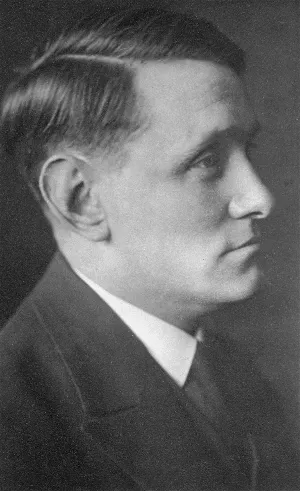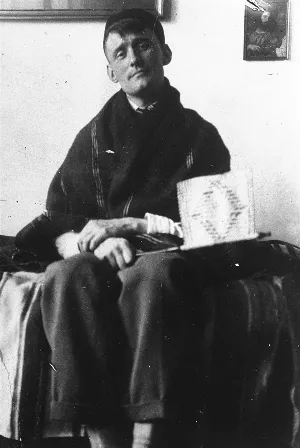
In the final days before his execution in July 1943 at the hands of the Nazis, Willem Arondeus asked his lawyer for one last request: to spread a message after he was gone.
"Let it be known," he said, "homosexuals are not cowards."
A battle cry of defiance and a bold assertion of his strength, these were the words Arondeus had lived his life by. He was openly gay man and a tireless member of the Dutch resistance against the Nazi occupation of the Netherlands, and he willingly sacrificed his life for a mission that protected saved the lives of thousands of Jews.

A budding artist struggling to survive
From an early age, Arondeus was no stranger to defiance. Born in 1894 as the youngest of six siblings in Naarden, Amsterdam, Arondeus constantly fought with his parents about his sexuality.
Often deemed the birthplace of LGBT rights, Amsterdam decriminalized homosexuality in 1811, but restrictive rules still barred homosexuality in the early 20th century. In 1911, the ruling political parties in the Netherlands raised the age of �consent for homosexual activity to 21 – even though the age of consent for heterosexual activity remained at a more permissive 16. Although the first gay bar in the Netherlands would open its doors �soon afterward, these restrictive age rulings, along with laws against public indecency, were used to unfairly target gay men.
But these laws did not intimidate Arondeus. He refused to suppress his identity as a gay man, and he left home at age 17, severing ties with his family. Living on his own, he struggled financially, picking up work where he could find it, but he also pursued his passion for writing and painting for the next three decades. He would go on to complete a mural for the Rotterdam Town Hall in 1923, and, later, write a biography of Dutch painter Matthijs Maris, published in 1938. During this time he met his partner, Jan Tijssen, whom he lived with for seven years.
Arondeus quickly learned, though, that persistent discrimination against LGBT citizens made life difficult in the Netherlands. Heo struggled to find housing, not just because he was poor but also because he refused to hide his sexuality.
"Willem, as an exception, lived as openly as he could," Klaus Mueller, the European representative for the United States Holocaust Memorial Museum, said in July during a virtual event , "Pride Month: Defying Nazi Persecution." "In his diaries... he wrote about being kicked out of apartments because he was gay, there was no protection."
A call to activism
While Arondeus had many artistic talents, today he is much more recognized for his courageous acts of rebellion as a member of the Dutch resistance during World War II. He joined the resistance in 1940, and it was there that he truly made his mark.
"When you read [his] diary you see an insecure artist, even doubting his own success... he always felt like an outsider ," said Mueller. "But when he joined the resistance, he found his own voice – you see a man who is determined, who knows the risks, but doesn't feel like an outsider anymore."
Though Arondeus was focused on defending the safety of the Dutch Jews, he and other LGBT citizens also saw the imminent threat of the Nazis to their community.
Upon their occupation of the Netherlands at the start of the 1940s, the Germans brought with them Paragraph 175 – a law first introduced by Hitler in Germany in an effort to cleanse the country of homosexual activity. The ruling, which began by expelling any gay and lesbian organizations in Germany, was revised to make homosexual activity between men punishable by imprisonment. Even the slightest evidence could land them behind bars, and Paragraph 175 saw �over 100,000 German men arrested for homosexual activity and 50,000 imprisoned.
Imprisonment was not the only danger. Over the course of the Nazi era, between 5,000 and 15,000 gay men were sent to concentration camps. Marked as homosexual by pink triangle badges, these men were brutally abused, and many underwent experimental medical treatments allegedly aimed at "curing" their sexuality.
Aware of this dire threat, Arondeus sprang into action right at the start of the Nazi occupation. Along with publishing anti-Nazi information, he and other members of the resistance created roughly 70,000 false identification cards for Dutch Jews, preventing them from being tracked down by the Nazis.
Yet over time, the Nazis began to catch onto the forged documents, which could be double checked at the Amsterdam registry building. Intensifying their tactics, �Arondeus and the rest of his unit constructed their riskiest plan yet: they would blow up the registry building – along with the hundreds of thousands of documents inside.
Frieda Belinfante, an openly gay woman who fought alongside Arondeus in the resistance and participated in the bombing plan, said that while they both knew their lives were at risk if they were caught, they also knew they had to carry out this mission.
"He said, 'Do you think we'll see the end �of this war?' and I said 'I don't think so,' and he said 'I don't think so either,'" Belinfante remarked during the panel, recalling a conversation the two had had before carrying out their plan. "And then he said 'Do you mind?' and I said 'No I don't,' and he said, 'I don't either.'"
On March 27, 1943, Arondeus led a group of resistance fighters into the registry building. Disguised as Dutch police, they drugged the guards, and blew up the building, and destroyed about 800,000 identity cards.
Yet, just several days later, on April 1, an anonymous source denounced Arondeus and he was arrested. Though he attempted to take full responsibility for the attack and refused to give up the names of his team, his notebook was discovered, revealing the identity of many others in the resistance.
Some were able to flee the country, but exactly three months later, Arondeus and 12 others – including two other gay men – were lined up before a firing squad and executed.
A legacy overshadowed
Though the bombing of the Amsterdam registry building was widely regarded after the Holocaust as a lifesaving moment in history, education about the heroic event erased Arondeus's leadership because he was gay.
So, while his family did receive a posthumous medal of honor for Arondeus's sacrifices, the homophobia that persisted throughout the 1950s and 1960s prevented LGBT war heroes like Arondeus from getting the recognition they deserved. This went against Arondeus's final message to his lawyer; he had wanted the world to know about LGBT participation in the mission.
It was only in 1984 that Arondeus was awarded the Resistance Memorial Cross, and in 1986 that he was posthumously �granted the honorific Righteous Among the Nations– an honor given by the state of Israel to non-Jews who protected the rights of Jews during the Holocaust.
And in 1990, he finally got his wish to be recognized not only as a hero, but as a member of the LGBT community. His sexuality was revealed in a TV program, and the Dutch public finally learned the true extent of his bravery, forever cementing his memory a hero of the LGBT community.
"He was a great hero, who was most willing to give his life for the cause," Belinfante said.
To learn more about Willem Arondeus, visit the United States Holocaust Memorial Museum's website about Arondeus, https://encyclopedia.ushmm.org/content/en/id-card/willem-arondeus, and its Pride month presentation, https://www.youtube.com/watch?v=RuqRHGP_upo

